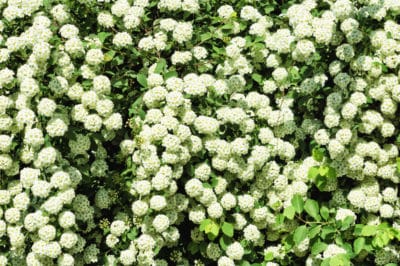The Ornamental Charms
As a visually appealing hedge, hawthorn certainly deserves consideration.
- In mid- to late spring, masses of five-petaled white, reddish or pink blooms nearly conceal its leaves. They’re so impressive that the British have dubbed hawthorns “May-trees.”
- By mid-fall, hawthorns are heavy with clusters of edible, ruby-red or black berries. They persist into winter, feeding sparrows, cedar waxwings, grouse and other birds.
- In winter, the exposed black branches of a neatly trimmed hawthorn hedge make a stunning counterpoint to its berries.
The Ornamental Drawbacks
Each hawthorn hedge ornamental virtue unfortunately comes with a corresponding fault:
- The flowers saturate the spring air with triethylamine, a chemical smelling of decaying meat.
- The berries — and the droppings of berry=feasting bird — might stain structures, walkways or driveways.
- Most hawthorn varieties sport needle-sharp, 1/2- to 3-inch thorns threatening to passers-by and pets.
The Wildlife Value
Hawthorn hedges aren’t just wintertime bird buffets. They’re dense nesting habitats. Planted along grassy meadows or prairies, they shelter mice and other small creatures from swooping birds of prey.
On the downside, birds and small rodents hanging around a hawthorn hedge could easily lure the family cat into a tangle of thorns.
Pruning
If you don’t like pruning thornless hedges, you’ll really hate pruning hawthorns. That is, unless you plant a hedge of thornless cultivars, such as ‘Winter King’ (Crataegus viridis ‘Winter King”). Like most hawthorns, it’s suitable for USDA plant hardiness zones 4 through 7.
Safely pruning hawthorns requires:
- Heavy, forearm-length leather gloves.
- Protective eyewear.
- Long-handled, swivel-headed pruners.
- Disposing of the branches where they won’t injure anyone else.
Other Problems
Several insects and diseases transform hawthorn hedges into eyesores. Aphids or scales may coat them in sticky honeydew covered with greasy, black sooty mold. Powdery mildew spores turn them white overnight. Fire blight blackens their new growth from the tips inward and bends their branches into shepherd’s hooks.
Expert gardener’s tip: Besides being nearly thornless, ‘Winter King’ pairs the best of hawthorn’s ornamental qualities with improved disease resistance.
